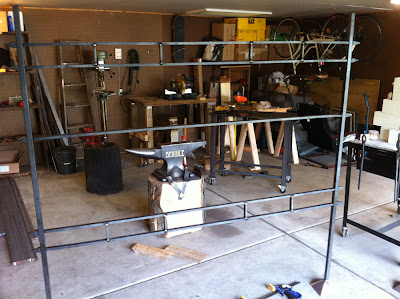Update #4
In my artistic process, there are several galvanizing moments in each project that energize me and allow me to proceed in what is an otherwise difficult and trying vocation. The first of these moments is always the conception of the project, that initial spark of an idea. “Hey, what if I …” In Soundforge, I am well past that now. The second moment usually occurs well into the fabrication of a work and is the realization that, yes, the initial idea can, and is currently, being realized. Call it a moment of actualization.
 |
| Welding the first foot onto the armature newel. |
I had that actualizing moment recently, as I completed fabricating the feet of the armatures for Soundforge. After some fitting and situating, I welded them on and, behold, Soundforge can stand! Having no previous large-scale steel fabrication experience, this was trying. With silver, I could just force the thing into place; however, plate steel has a much stronger will. The fact that, structurally, the work functions is boon to confidence and more generally a milestone in the creation of the project. I can see it coming together, and I know, finally, that it will work.
It is these energizing moments – where vision meets reality, where the hand approximates the imagination – that make being an artist worth the doldrums. Yes, I know that is a bit cliché, but it is true. I had one of those moments, and I am sharing it. Soundforge stands!
 |
| A shot of the first free-standing armature just inside my studio, adjacent to my lush mid-western garden. |
Update #5
The past few weeks have been among my favorite on the project. A lot of the tedious and trying fabrication is done, and now I am at the anvil all day – every day. I am making small forgings, listening to music and books on tape, losing myself for hours as I sweat in the near-hundred-degree heat of my shop. It’s not Texas-hot to be sure, but 90 degrees with 90-percent humidity, plus a forge running, is not exactly mild.
 |
| After forging 36 three-inch ornamental finials, I worked on their layout within the 3 x 12 inch frames on the armature. |
My interest and love of moving metal is at least in part why I got into this project, and I have been able to watch myself improve in strength, stamina and toughness everyday. Manual labor, in any form, can be a meditation, but aside from enjoying the work, I am intermittently aware of the battle between the work and my body. Hard labor has a decidedly penal connotation in my mind, but I think there can be no other way to describe forging such thick material, by hand, for such durations. Don’t mistake this for a complaint, because I do not loathe the work, but rather it has caused me to consider labor as more than simply a romantic extension of my idyllic principals.
There is a cost to smithing – beyond the material and the tools, that is. Smithing is bought in scale burns, calluses and stinging hands in the morning. The cost of 36 finials is that of aching joints, tired feet and singed arm hairs. But for each hammer blow, I am more tenacious, sinewy and graceful in my work. Forging might cost more physically than most other forms of manual labor, but there is something compelling about the hammer, which makes it perhaps the most revered tool throughout human history. It draws people in. Most people think wielding a hammer is about power – the sledge in the carnival game where one tries to ring a bell. Yes, power is the hammer’s attraction; it is a tool that reflects our aspirations of strength. It is also, perhaps, the simplest of all hand tools. However, this is deceiving because anyone worth their salt with a hammer knows that strength does not matter if you miss your target. To watch someone experienced with a hammer is nearly always a moment of wonder. Everyone can understand the simplicity of the hammer--you swing it, and you move something. In the hands of an expert, we can see skill personified; we recognize an unpretentious tool performing extraordinary work. The hammer is the ultimate vernacular tool, and it is the efficient use of it, as an action or performance, which allows us to see skill manifest.
--Gabriel Craig








